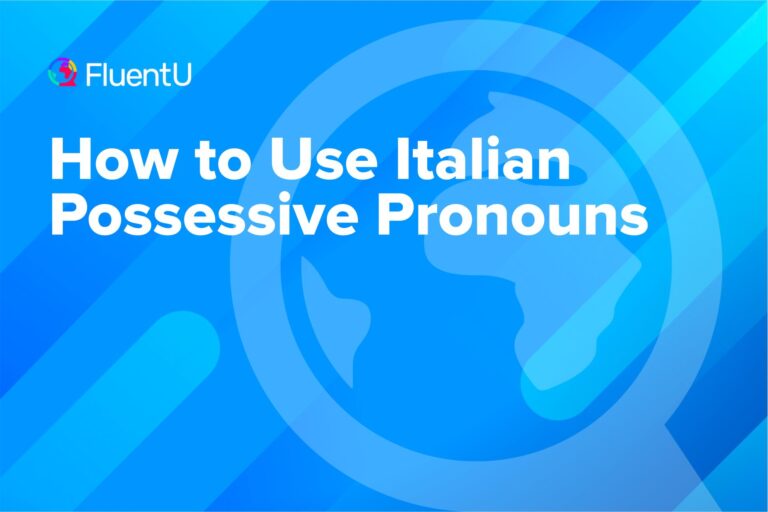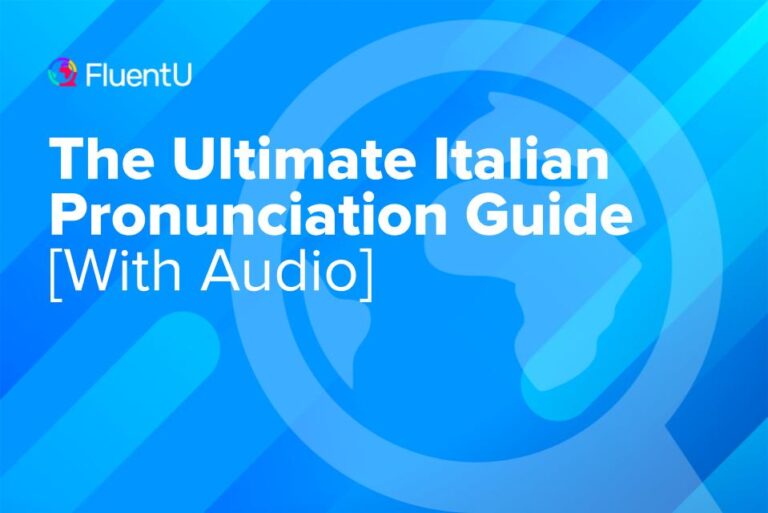The Complete Guide to Italian Grammar

When I decided to learn Italian, I quickly learned that there was nothing to be worried about. Italian grammar follows regular patterns that can be broken down into manageable categories, such as parts of speech and their various grammatical sub-categories.
Check out my guide which will introduce you to each part of speech and additional posts for more info on each grammar point.
Download: This blog post is available as a convenient and portable PDF that you can take anywhere. Click here to get a copy. (Download)
Nouns
In any language, nouns refer to people, places or things.
Italian nouns, though, have different characteristics than the nouns English-speakers are familiar with.
In addition to being singular or plural, Italian nouns can also be masculine or feminine.
In most cases, gender and number are communicated through the use of articles and the last letter of the word.
180+ Italian Nouns for Beginners | FluentU Italian Blog
There are thousands of Italian nouns to learn. Where should you start? Don’t worry: I’ve curated a list of 180 of the most important Italian nouns. Click here for a…
Articles
Articles are handy words that tell us the number and gender of nouns. Since every Italian noun can either be masculine or feminine and singular or plural, the article that precedes the noun cues us to these important distinctions.
The Italian definite article is used in front of nouns when we’re referring a specific instance of the noun.
In English, we use the word “the” as the definite article.
In Italian, the masculine singular definite articles are il (the) and lo (the).
Italian masculine definite plural articles are i (the) and gli (the).
il libro (the book)
i libri (the books)
lo studente (the student)
gli studenti (the students)
The feminine singular article is la (the).
The Italian feminine plural article is le (the).
la barca (the boat)
le barche (the boats)
la spiaggia (the beach)
le spiagge (the beaches)
The Italian indefinite article is used in the same way as the English “a” or “an” when referencing singular nouns.
When referring to singular masculine nouns, you use un (a) or uno (an).
Una (an) is used for a feminine noun.
È un treno veloce. (It is a fast train.)
È una bicicletta rossa. (It is a red bicycle.)
The Easy Guide to Italian Articles | FluentU Italian Blog
Learning Italian articles can be confusing at first. But never fear, here’s the definitive guide to Italian definite and indefinite articles, all simply explained with…
Gender and Number
The vast majority of Italian masculine nouns end in -o when they are singular. When they are plural, most of them end in -i.
albero (tree)
alberi (trees)
libro (book)
libri (books)
Most feminine nouns end in -a when they are singular. When they are plural they take the -e ending.
casa (house)
case (houses)
anatra (duck)
anatre (ducks)
Case
In Italian, as in most other languages, cases tell you the grammatical function of a noun.
Italian has five cases:
caso nominativo (nominative case)
Also known as the subjunctive case, the nominative case refers to a noun that is the subject of a sentence (a.k.a. the noun/pronoun doing the action).
caso accusativo (accusative case)
The accusative case is concerned with the direct object in a sentence.
caso dativo (dative case)
The dative case, instead, refers to indirect objects, which are usually used with a preposition.
accusativo con caso dativo (accusative with dative case)
In this case, both an indirect and direct object are used together.
caso disgiuntivo (disjunctive case)
In the disjunctive case, also known as the prepositional case, objects are usually separated from the verb by a preposition.
Verbs
Verbs tell us what action is taking place in a sentence. You can’t make a sentence without them.
Italian verbs pack a lot of information into just one or two words: they tell us who is doing the action, when it took place, and even sometimes how the speaker feels about it.
Infinitives
Before you get to conjugating, we have to start with the most basic form of a verb: the infinitive.
It is always one word, and it almost always ends in -are, -ere or -ire.
camminare — to walk
correre — to run
pulire — to clean
In addition to being the form of the verb you see in the dictionary, it can also be used in certain sentence constructions.
Sono contenta di vedervi. — I am happy to see you all.
Devo studiare oggi. — I have to study today.
Mi piace leggere. — I like to read.
Verb Groups and Conjugation
Italian verbs end in -are, -ere or -ire.
Verb endings change depending on who is doing the action. This is that conjugation we were talking about.
The endings changed according to who was eating.
Conjugated -are verb endings are:
-o (I)
-i (you)
-a (he/she)
-iamo (we)
-ate (you)
-ano (they)
An example of a conjugated -are verb looks like this:
Cantare (to sing)
Io canto. (I sing.)
Tu canti. (You sing.)
Lui canta. (He sings.)
Lei canta. (She sings.)
Noi cantiamo. (We sing.)
Voi cantate. (You sing.)
Loro cantano. (They sing.)
Conjugated -ere verb endings are:
-o (I)
-i (you)
-e (he/she)
-iamo (we)
-ete (you)
-ono (they)
An example of a conjugated -ere verb looks like this:
Vincere (to win)
Io vinco. (I win.)
Tu vinci. (You win.)
Lui vince. (He wins.)
Lei vince. (She wins.)
Noi vinciamo. (We win.)
Voi vincete. (You win.)
Loro vincono. (They win.)
Conjugated -ire verb endings are:
-o (I)
-i (you)
-e (he/she)
-iamo (we)
-ite (you)
-ono (they)
An example of a conjugated -ire verb looks like this:
Partire (to leave)
Io parto. (I leave.)
Tu parti. (You leave.)
Lui parte. (He leaves.)
Lei parte. (She leaves.)
Noi partiamo. (We leave.)
Voi partite. (You leave.)
Loro partono. (They leave.)
140 Most Common Italian Verbs | FluentU Italian Blog
Learn the 140 most common Italian verbs, so your Italian will be vibrant and active. Check out this Italian verb list of the most used verbs so you can sound more fluent…
Conoscere vs. Sapere in Italian: The Two Verbs of Knowing | FluentU Italian Blog
Did you know there are two ways to say “to know” in Italian? Check out this post to learn when to use “conoscere” vs. “sapere.” You’ll also learn how to conjugate both of…
Essere vs. Avere: When to Use Them | FluentU Italian Blog
Learn about essere vs avere with this post! These verbs might be unassuming but they’re two of the most important and useful words in the Italian language! You’ll also see…
“To Be” in Italian: The Simple Guide to Conjugating Essere | FluentU Italian Blog
“To be” in Italian is essere, and it will help you say anything from “I am” to “This is a long movie!” In this guide, I’ll break down everything you need to know about the…
How and When to Use “Stare” in Italian | FluentU Italian Blog
Learn how to use and conjugate “stare” in Italian with this complete guide! “Stare” might simply mean “to stay” in English, but it’s used for so much more in Italian. From…
Italian Auxiliary Verbs for Beginners | FluentU Italian Blog
Italian auxiliary verbs can give you hand whenever you need to communicate in the language. Thanks to three small yet mighty words (essere, avere and stare), you can form…
Verb Tenses
Verb tenses tell us whether an action took place in the past, present or future.
I don’t want to alarm you, but there are a total of 21 verb tenses in Italian. Yikes!
Before you click away, just know that you don’t need to master ALL of those forms to have a conversation.
Here are the tenses you’re most likely to come across when learning Italian:
presente (present tense)
Present tense is used when you are describing something that is taking place in the current moment.
passato prossimo (simple past)
Also known as present perfect tense, passato prossimo is used for action that both began and ended in the past, and requires avere or essere as an auxiliary verb, as most past tenses do.
imperfetto (imperfect)
The imperfect tense is for actions that happened habitually in the past, actions that started in the past and are still ongoing, or an ongoing action that was going on when something else happened.
trapassato prossimo (past perfect)
Past perfect tense is a bit like “the past of the past”: it is a past action that took place before another action that also took place in the past.
passato remoto (remote past)
Typically used in literature or to talk about historical happenings, the remote past tense is usually only used in writing, and unlike other past tenses, does not take an auxiliary verb.
trapassato remoto (preterite perfect)
Also known as past anterior tense, this one is for a past action that happened right before a passato remoto action took place.
Futuro semplice (simple future)
This tense is used to speak about events that will happen in the future, as well as to make predictions and plans.
Futuro anteriore (future perfect)
Future perfect tense is used to describe an action that will have happened before another action happens in the future.
Italian Verb Conjugation: The Essential Guide | FluentU Italian Blog
Italian verb conjugation might be tricky, but we’ll break it down for you in this straightforward guide. Read on to learn how to conjugate Italian verbs in the present,…
Italian Future Tenses: Conjugations, Uses and Key Rules | FluentU Italian Blog
The Italian future tenses are important. After all, you have a lot of hopes and dreams for the future! Use this guide to learn about the two main future verb tenses: the…
Italian Past Tense: A Comprehensive Guide | FluentU Italian Blog
Want to step up your game by learning how to use Italian past tenses with confidence? You’ve come to the ultimate guide to the Italian past tense! We’ll look at the basics…
The Formal “You” in Italian: a Complete Guide | FluentU Italian Blog
The formal you in Italian can be difficult to use. Read this complete guide for when to use the formal and when to use the informal you in Italian. We also include the…
Verb Aspect
Italian verb aspects give you more information about when an action took place or whether it is still going on.
Aspects are typically denoted by the verb tense and conjugation, and can be broken down into three main categories:
aspetto perfettivo (perfective aspect)
The perfective aspect describes an action that is complete.
aspetto imperfettivo (imperfective aspect)
The imperfective aspect concerns actions that are continuous or ongoing.
aspetto durativo (durative aspect)
The durative aspect is used when an action lasts over time.
Verb Mood
In addition to tense and aspects, verbs can also have moods.
Italian verb moods tell you how to speaker feels about the action they’re describing, or how certain they are about it.
It can also be used to express dreams and wishes, hopes and probabilities, and hypothetical situations.
There are seven of these moods.
indicativo (indicative)
The indicative mood is the most-used mood, since it describes things that have happened, are happening, or will happen in reality.
imperativo (imperative)
The imperative mood is used to give commands or orders.
congiuntivo (subjunctive)
The subjunctive mood is used to express hopes, dreams, wishes, opinions, probability, or possibilities.
condizionale (conditional)
The conditional mood is for hypotheticals, or things that would happen if some other action took place.
infinito (infinitive)
You’ve seen the infinitive before in an earlier section: it’s the base form of the verb.
participio (participle)
Participles are broken down into present and past: the former turns the verb into a noun or adjective, the latter is used to form many of the two-word past tense constructions we spoke about earlier.
gerundio (gerund)
Gerunds correspond to -ing verbs in English and are used to form continuous verb tenses.
How to Use Commands in Italian | FluentU Italian Blog
You must learn about commands in Italian! The imperative case in Italian is used to give orders and commands. In this guide, you’ll discover the different forms of Italian…
Adjectives
Adjectives are descriptive words that modify nouns. They give details about the nouns they describe—which makes any language much more vivid and interesting!
To get you started, some common adjectives are:
bello (beautiful)
brutto (ugly)
buono (good)
caldo (hot)
cattivo (bad)
diverso (different)
freddo (cold)
giovane (young)
grande (large)
nuovo (new)
piccolo (small)
stesso (same)
tranquillo (quiet)
vecchio (old)
Endings: Gender, Number and Agreement
Adjectives must agree in gender (masculine or feminine) and number (singular or plural) with the nouns they modify.
Rosa ha comprato un vestito verde. (Rosa bought one green dress.)
Rosa ha comprato tre abiti verdi. (Rosa bought three green dresses.)
Leo ha un vecchio cappotto. (Leo has an old coat.)
Leo ha due vecchi cappotti marroni. (Leo has two old brown coats.)
Adjective Placement
Italian adjectives are the opposite of their English counterparts, in that most of them come after the noun.
una casa piccola (a small house)
un maglione blu (a blue sweater)
Sometimes, though, you can change the adjective’s meaning by placing it before the noun.
un vecchio amico (a friend you have had for a long time)
un amico vecchio (a friend who is old in terms of age)
One way to keep things straight is to remember that figurative, more abstract adjectives come before the noun, and literal adjectives come after.
So if a book is literally big (grand) in size, you would call it un libro grande.
If it is grand because it is well-written or important, it would be un grande libro.
125 Italian Adjectives | FluentU Italian Blog
This post gives you everything you need to be a master at using Italian adjectives. You will find a guide on how Italian adjectives work including placement, gender, and…
How to Use Italian Superlatives | FluentU Italian Blog
Italian superlatives are the best! No, really—superlatives can add detail and emphasis to your Italian conversations and writing! In this post, you’ll learn all about…
Adverbs
Adverbs are words that provide details about verbs. In other words, they tell how something is happening or has happened.
Adverb Endings
Italian adverbs generally end in -mente.
Lou guida lentamente. (Lou drives slowly.)
Adverb Placement
Just like most adjectives are placed after the noun in a sentence, adverbs come after the verb.
Parli bene l’inglese. (You speak English well.)
To add emphasis, you can put the adverb at the beginning of the sentence.
Ora non posso farlo. (I can’t do it right now.)
When using adverbs like mai (never) and già (already), they are placed between the two parts of the past tense verb.
Serena non è mai stata in America. (Serena has never been to America.)
Ho già visto questo film. (I already saw this movie.)
Adverb Types
There are several different types of Italian adverbs, all of which describe verbs in a different way.
- avverbi di modo o maniera (adverbs of manner)
These adverbs describe either how/in what way the action is being done. - avverbi di tempo (adverbs of time)
Adverbs of time describe when something happened or will happen. - avverbi di luogo (adverbs of place)
Adverbs of place describe where the action happens. - avverbi di quantità (adverbs of quantity)
These typically answer the question “how much?”. - avverbi di giudizio (adverbs of modality)
Adverbs of modality affirm or negate action, or communicate doubt, uncertainty, or exclusion.
Some common adverbs include:
facilmente (easily)
felicemente (happily)
generalmente (generally)
gentilmente (kindly)
rapidamente (rapidly)
veramente (truly)
Some common adverbs of time and place are:
oggi (today)
domani (tomorrow)
ieri (yesterday)
là (there)
qui (here)
Italian Adverbs of Frequency: Rules, Examples and More | FluentU Italian Blog
Italian adverbs of frequency are essential and will help you express how often something happens. Here I’ll teach you seven of the most common Italian adverbs of frequency…
Pronouns
Subject Pronouns
Subject pronouns are used for the subject of a sentence. They tell us who is doing something—eliminating the need to use a proper name to identify the subject.
Italian subject pronouns are:
io (I)
tu (you)
lui (he)
lei (she)
noi (we)
voi (you)
loro (they)
The pronoun precedes the conjugated verb, like this:
Io mangio. (I eat.)
Tu mangi. (You eat.)
Lui mangia. (He eats.)
Lei mangia. (She eats.)
Noi mangiamo. (We eat.)
Voi mangiate. (You eat.)
Loro mangiano. (They eat.)
Object Pronouns
Object pronouns show who is the object of a verb’s action.
Italian object pronouns are:
mi (me)
ti (you)
lo (him)
la (her)
ci (us)
vi (you all)
li (them, masculine)
le (them, feminine)
They are placed before the verb, like this:
Mi vedi? (Do you see me?)
Lo vedi? (Do you see him?)
How to Use Italian Possessive Pronouns | FluentU Italian Blog
Italian possessive pronouns are an essential part of the language. After all, what’s mine is mine and what’s yours is yours! Or maybe you’re a great sharer and what’s…
The 12 Most Common Italian Relative Pronouns | FluentU Italian Blog
Italian relative pronouns can be just as hard (if not harder) to master as their English counterparts “that,” “which,” “who,” and “whom.” So how do you get them straight?…
Prepositions
Prepositions are short words, usually just a few letters long, that link words.
The most common prepositions are:
a (in or to)
Lavoro a Roma. (I work in Rome.)
Vado al lavoro. (I go to work.)
con (with)
Mangiamo spaghetti con le polpette. (We eat spaghetti with meatballs.)
da (from)
Vengo da Roma. (I come from Rome.)
di (of)
Ho comprato una camicia di seta. (I bought a silk shirt.)
per (for)
È per te. (It is for you.)
The Complete Guide to Italian Prepositions | FluentU Italian Blog
Italian prepositions can be tricky, so we’ve created this comprehensive guide which gives you the down-low on the most used prepositions. We include meaning, contractions,…
Conjunctions
Conjunctions are like little bridges that connect clauses.
Clauses are separate ideas that can be connected to form a larger statement.
There are many conjunctions in Italian. As your Italian vocabulary grows, you will naturally learn the less common ones.
Some of the more popular and useful conjunctions include:
allora (then)
Se hai fame, allora mangeremo. (If you are hungry, then we will eat.)
e (and)
Vorrei pasta e un bicchiere di vino. (I would like pasta and a glass of wine.)
dopo (after)
Andremo al ristorante dopo essere andati al negozio. (We will go to the restaurant after we go to the store.)
o (or)
Comprerò l’abito o le scarpe. (I will buy the dress or the shoes.)
ma (but)
Mi piacciono le scarpe, ma mi piacciono di più gli stivali. (I like shoes, but I like boots more.)
perché (because)
Mi piace la torta perché è dolce. (I like cake because it is sweet.)
prima (before)
Andremo al negozio prima di andare al ristorante. (We will go to the store before we go to the restaurant.)
Italian Conjunctions: Types, Examples and Usage Notes | FluentU Italian Blog
Italian conjunctions are small words that connect thoughts, words and ideas. Click here to learn 30 common conjunctions in Italian, like “quindi,” “oppure,” “mentre” and…
Sentence Structure
Learning Italian sentence structure is a snap!
It is wonderfully straightforward and uncomplicated. As long as you know your parts of speech and have a basic vocabulary, you will be competent enough to formulate simple Italian sentences.
Basic sentences follow the formula subject, verb and then object.
Rosa studia matematica. (Rosa studies math.)
Louis mangia la torta. (Louis eats the cake.)
Si arrampicano sugli alberi in estate. (They climb trees in the summer.)
Lei scia in inverno. (She skis in the winter.)
Rosa legge un buon libro. (Rosa reads a good book.)
Dominic guida un’auto veloce. (Dominic drives a fast car.)
Una bella donna mangia il gelato. (A beautiful woman eats ice cream.)
Questions
Questions in Italian ask the same things questions in English do: mostly chi (who), che cosa/che/cosa (what), quando (when), dove (where), perchè (why) and come (how).
You can also ask qual/quali (which) or quanto (how much).
To form a question that begins with one of these interrogative words, the subject must come at the end of the sentence.
Quando arriva tua sorella? (When does your sister arrive?)
A preposition should never come at the end of a question.
Di dove sei? (Where are you from?)
When the question word is an adjective, it must agree with the number and gender of the noun it is referring to.
Quali sono le mie scarpe nuove? (Which ones are my new shoes?)
Quanti anni hai? (How old are you? Literally: How many years do you have?)
Here are a few more examples of standard question constructions:
- Chi è lui? (Who is he?)
- Che cosa hai fatto ieri? (What did you do yesterday?)
- Quando arriva il prossimo treno? (When does the next train arrive?)
- Perché mi hai chiamato? (Why did you call me?)
- Come sta tua nonna? (How is your grandmother?)
8 Italian Question Words [with Examples and Audio] | FluentU Italian Blog
Knowing Italian questions words is essential for communicating effectively. Check out our complete guide on asking questions in Italian so you can inquire and learn new…
Exclamations
Mamma mia!
Exclamations in Italian are usually used to convey emotions like surprise, happiness, anger, disgust, or enthusiasm.
There are several different ways you can form an exclamation. The first is simply to use che + an adjective.
Che stress! (How stressful!)
Che peccato! (What a shame!)
Che schifo! (How disgusting!)
If you want to comment on a large amount of things, you use the construction Quanto/a/i/e + a noun.
Quanti soldi! (What a lot of money!)
Quante mosche! (What a lot of flies!)
You can also use some nouns, verbs, and adjectives as an exclamation.
Dai! (Come on!)
Mannaggia! (Dang it!)
Forza! (Be strong! or You can do it!)
Zitto! (Silence!)
And sometimes, exclamations are made-up words created just for the purpose of exclaiming something.
Uffa! (How boring!)
Boh! (I have no idea!)
30 Italian Exclamations to Be More Expressive | FluentU Italian Blog
Italian exclamations extend far beyond the ubiquitous “Mamma mia!” Some of these exclamations have a pretty straightforward meaning and usage (e.g., “salute” means…
Casual Speech
Unfortunately, after learning all the grammar rules in Italian, you still probably won’t sound like a native speaker right away.
This is because most of the conversational skills you learn are more formal than those used in most conversations.
If you really want to sound like an Italian, you have to also learn to be relax and be casual. Here’s how:
Use the Right Form of “You”
In Italian, there are two forms of the pronoun “you”: the formal you and the informal you.
Lei is the formal way to address someone, but tu is the casual form.
In most normal, everyday conversations with people you know, you’d use the latter to keep it casual.
Learn the Lingo
Another way to sound more casual when speaking Italian is to use certain phrases that are usually “looser” forms of normal/formal phrases.
Many, for instance, use a different verb conjugation than usual, shorten words, or use a combination you wouldn’t expect.
Some phrases even break the rules of grammar you just spent so much time learning.
Here are some examples:
Come va? (How’s it going?)
Dai! (Come on!)
Meno male (Thank goodness)
Figurati! (No worries!)
Sei scemo (You’re mean)
Fare il grande (to act like you’re better than everyone)
Once you familiarize yourself with the rules of Italian grammar as they apply to the parts of speech, remember to keep a lookout for them in everyday conversations and native content. Programs like FluentU are especially helpful for pointing naming grammar points so it takes the guesswork out of differentiating between the parts of speech.
FluentU takes authentic videos—like music videos, movie trailers, news and inspiring talks—and turns them into personalized language learning lessons.
You can try FluentU for free for 2 weeks. Check out the website or download the iOS app or Android app.
P.S. Click here to take advantage of our current sale! (Expires at the end of this month.)
Remember, practice makes progress—so keep at it to see your Italian fluency emerge!
Download: This blog post is available as a convenient and portable PDF that you can take anywhere. Click here to get a copy. (Download)
And One More Thing...
If you're as busy as most of us, you don't always have time for lengthy language lessons. The solution? FluentU!
Learn Italian with funny commericals, documentary excerpts and web series, as you can see here:
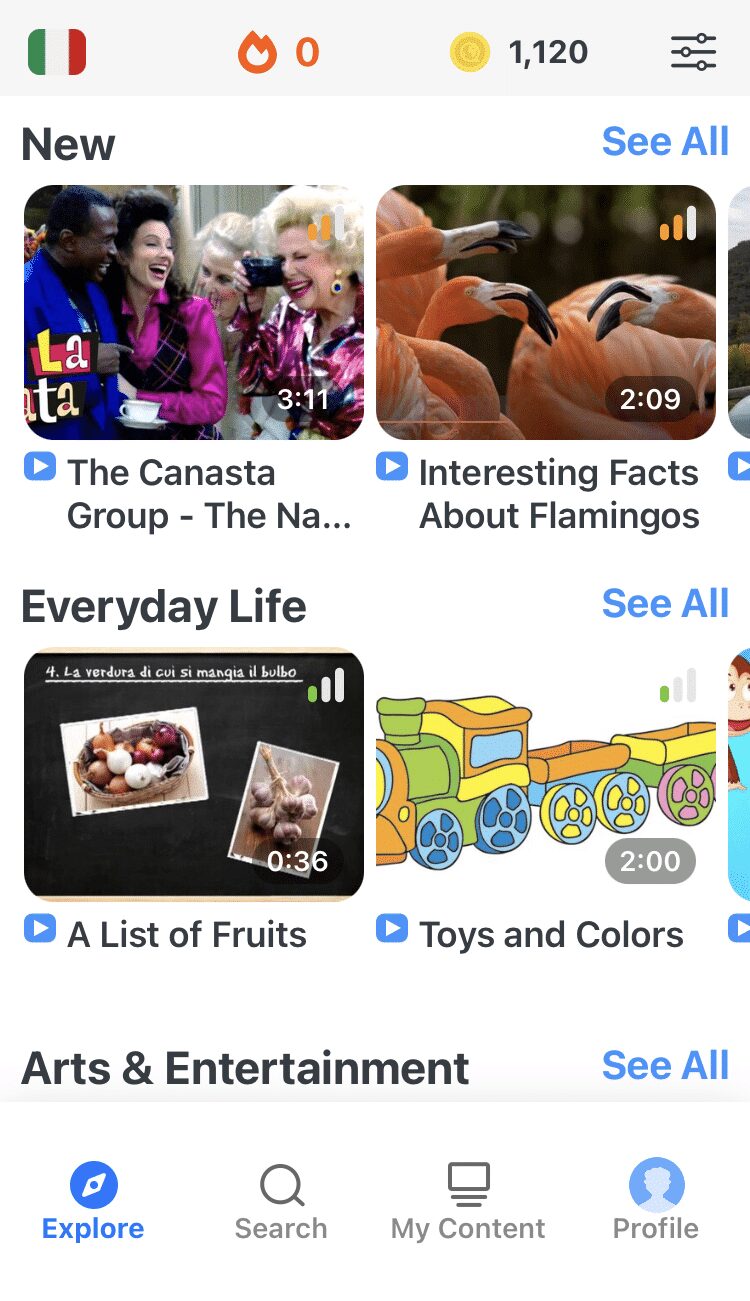
FluentU helps you get comfortable with everyday Italian by combining all the benefits of complete immersion and native-level conversations with interactive subtitles. Tap on any word to instantly see an image, in-context definition, example sentences and other videos in which the word is used.
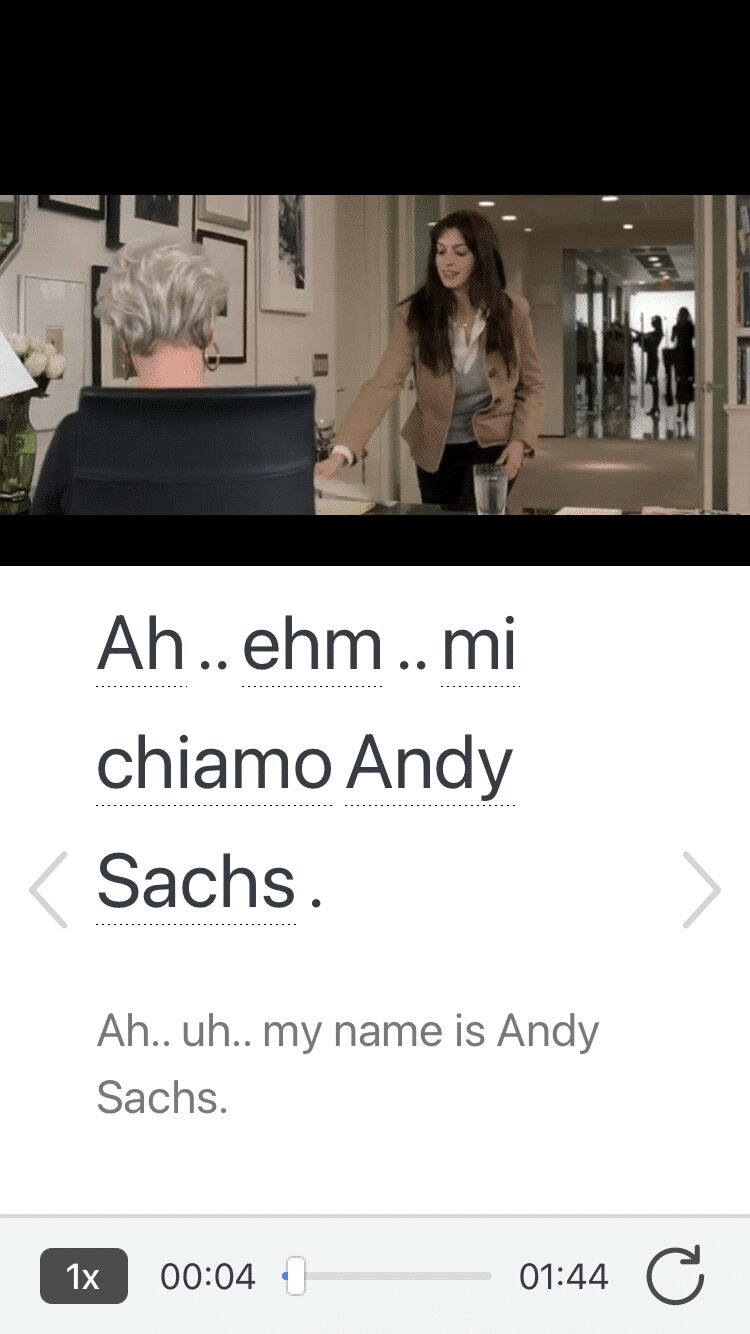
Access a complete interactive transcript of every video under the Dialogue tab, and review words and phrases with convenient audio clips under Vocab.
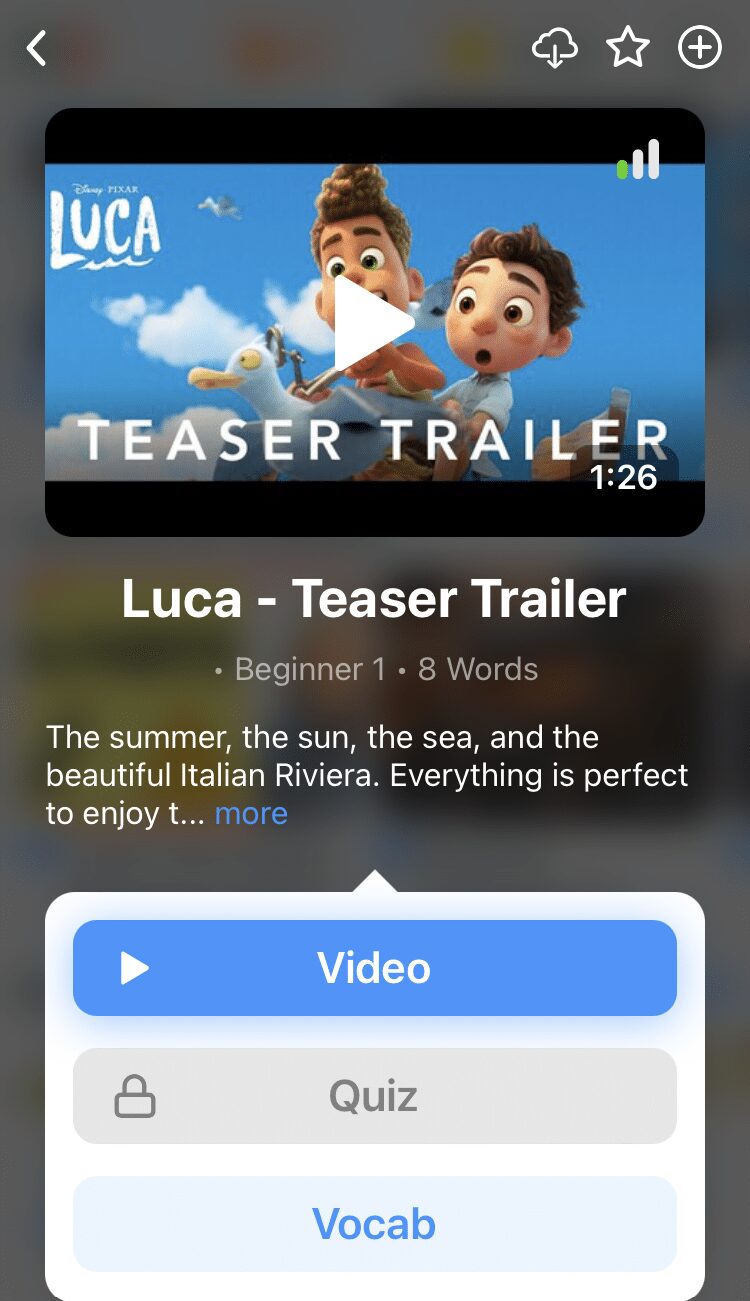
Once you've watched a video, you can use FluentU's quizzes to actively practice all the vocabulary in that video. Swipe left or right to see more examples of the word you’re on.
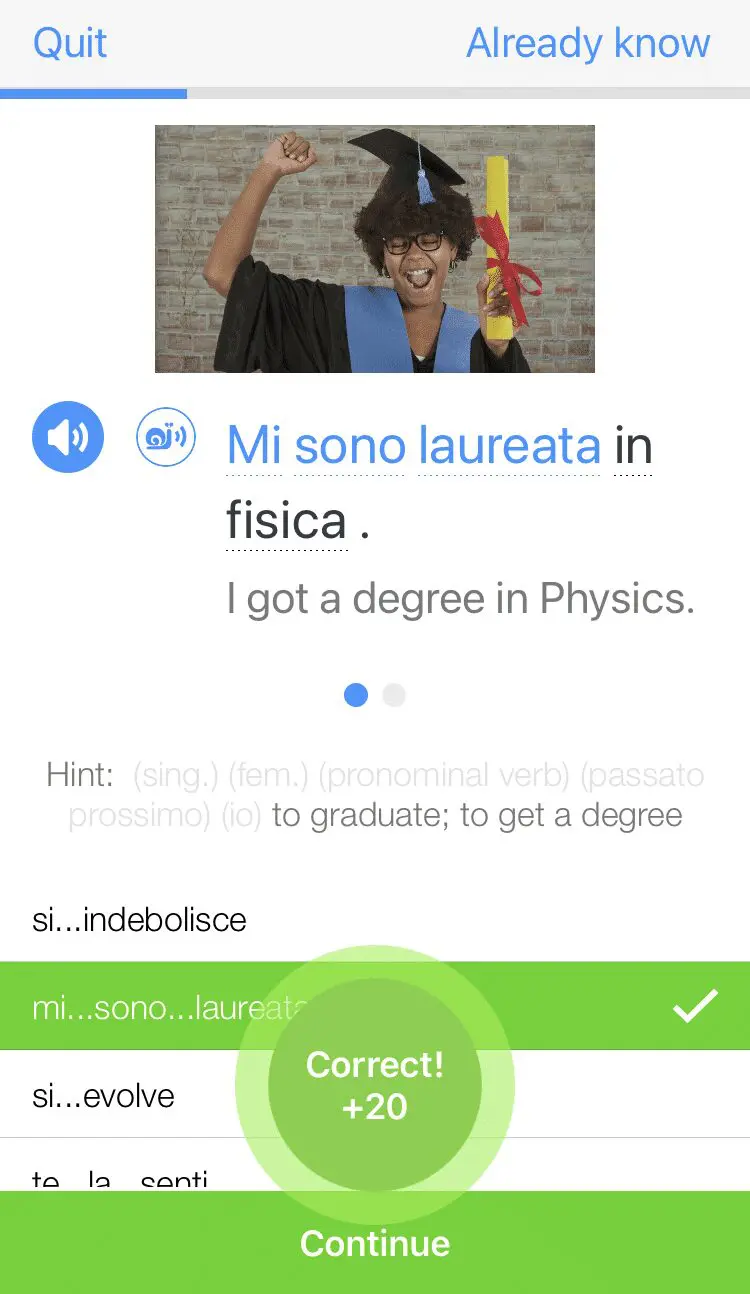
FluentU will even keep track of all the Italian words you’re learning, and give you extra practice with difficult words. Plus, it'll tell you exactly when it's time for review. Now that's a 100% personalized experience!
The best part? You can try FluentU for free with a trial.
Start using the FluentU website on your computer or tablet or, better yet, download the FluentU app from the iTunes or Google Play store. Click here to take advantage of our current sale! (Expires at the end of this month.)

